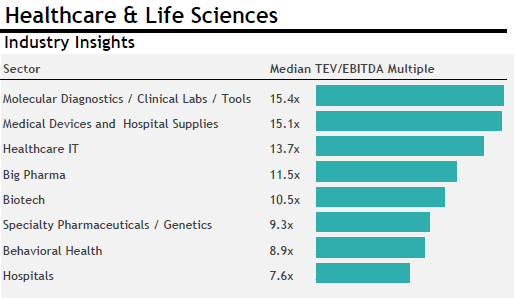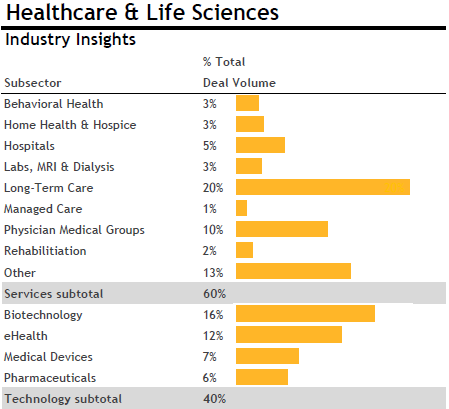M&A Risks in the Middle Market Healthcare Services Sector
Merger and acquisition (M&A) activity in 2017 was at a high level with:
-
An enormous amount of capital available
-
Low borrowing costs
-
A strong equities market and
-
A low rate of organic growth in many sectors of the economy
One industry sector that continues to be very active is healthcare services. This sector covers a broad array of services such as acute care, chronic care, and technology. There is a higher than average level of M&A activity in this area even though transaction multiples tend to be higher than in many other sectors.

Source: S&P Capital IQ
M&A activity in the healthcare and life sciences sectors has been driven predominately by increased regulation in the marketplace, and consolidation of a fragmented marketplace to create economies of scale as larger networks look to save on the cost of compliance. In addition, long-term care M&A activity remains high as interest rates continue to be relatively low. Healthcare technology activity continues to be strong as investors look to capitalize on bridging the gap between higher value care at a lower cost.

Source: S&P Capital IQ
Increased Use of Electronic Health Records Due to Meaningful Use Requirements
According to The Office of the National Coordinator for Health Information Technology, meaningful use requirements have resulted in over 95% of hospital systems to use electronic health records if the hospitals have been eligible to receive Medicare and Medicaid. While meaningful use requirements began in 2011, many healthcare providers outside of the hospital setting and in the middle-market were neither required nor eligible to participate.
In some instances, it may not be cost effective for smaller health providers to completely automate their revenue cycle and health records. As a consequence, sellers of these smaller practices should be more transparent with potential buyers. Paper processes often lack visibility into a provider practice. This lack of transparency may create a potential risk of negatively impacting the overall transaction price. Likewise, if a seller is running too many systems and processes, this may decrease a buyer’s price point as it may be confusing for the buyer to interpret the data being generated. Further, a strategic buyer may perceive these systems to be more costly to integrate.
Evaluating Software Systems Related to Revenue Cycles and Patient Data
Healthcare companies use a variety of revenue cycle systems to schedule, perform services, invoice, and receive payments. These systems may provide vital information for a potential acquirer to assess trends within the healthcare service company. The systems could be considered by the buyer as a means to assist in managing its processes after the contemplated acquisition. It is important for a buyer to understand the target’s revenue cycle and should undertake a thorough review of the target’s processes and related documentation. A buyer’s request for information may include case data, types of services, dates, locations, amounts, primary payers, providers, times and other relevant data depending on the provider and available information.
While data obtained from the system may provide a potential buyer with essential information, it may be difficult to assess its validity. Thus, it is crucial for the buyer and the seller to understand the patient intake process, how data flows into the system, and how the data is extracted to be able to arrive at a mutual understanding of the data used to evaluate revenues and reimbursement variability.
Uncertainty of Reimbursement Rates and the Timing of Reimbursement
In the healthcare services sector, there continues to be uncertainty with regard to reimbursement rates. This often results in significant efforts when conducting due diligence to understand reimbursement trends from commercial payers (e.g., Aetna, BCBS, Cigna, United, and Humana) and government payers (e.g., Medicaid and Medicare) as well as others. Often a substantial effort is required to evaluate data to ensure reimbursement rates are reasonable.
For example:
-
Is the provider in-network or out-of-network?
-
How would reimbursement trends effect open cases?
-
What is the level of government reimbursement risk?
-
How long is the cash collection cycle?
-
Would the case be denied initially, or not paid at all, for a variety of reasons?
-
When does the service provider actually bill insurance payers?
-
What is the payment history of the payer in terms of days or months?
-
What is the historic case mix and how would this continue after the contemplated transaction?
The uncertainty as to reimbursement rates and the timing of reimbursements usually are noted in a quality of earnings report produced during due diligence. Typically, this would become an area of focus with an estimation of monthly or annual revenue adjustments in connection with the conversion of the cash basis method of accounting to the accrual basis method of accounting. The resulting adjustments could be significant and, likewise, could affect the financial terms of a contemplated transaction. For example, while the payments for patient billings may occur over or after a few months, it would not be uncommon for a complete settlement of claims to be made one year or longer following the date or end of service.
Other questions to consider in this regard revolve around trends in:
-
Collections of the percentage of claims over time
-
Rates of denied claims overall and for individual payers
-
Rates of paid claims by procedure or case mix by payer over time
All of these variables noted above may significantly affect reimbursement rates received by healthcare service providers. In addition, different payer contracts may lead to varying reimbursement rates. For example, a provider with a consistent delivery model may be reimbursed based on these models: (a) fee-for-service, (b) per case, (c) per diem, (d) per visit, (e) episodic, (f) managed care contract, (g) value based reimbursement, or (h) another reasonable method.
Case mix is another important variable that could impact provider reimbursement. For the most part, healthcare service companies cannot control their case mix. As a large number of healthcare procedures become reimbursed at higher rates based on the severity of the case, it becomes imperative that potential buyers evaluate data entry practices to ensure procedures performed by clinical professionals are captured. Healthcare providers with similar case mixes could have different levels of reimbursement rates if one provider does not capture all of the procedures performed.
As the transition to value-based reimbursement models gains momentum, a variety of requirements of payers and contracts may require the provider to document a variety of metrics or perform different procedures. For example, one payer contract may provide for a higher reimbursement based on structural measures. These structural measures may include a physician to patient ratio or the use of medical records. Another payer contract may provide for a higher reimbursement based on outcome. This could include hospital readmissions or mortality rates. Higher reimbursements may be based on process measures, such as the percentage of patients receiving preventative services. An understanding of the data needed to be captured and the determination of the best way to capture it, is key to maximizing reimbursement.
Providers should consider the following steps to maximize reimbursement:
-
Review time entry practices by clinical professionals to ensure full data capture
-
Evaluate clinical professionals time entry data
-
Establish best practices for data capture
-
Evaluate each payer contract and verify contractual requirements with clinical professionals
As payer models and healthcare services become more complex, a clear understanding between the clinical professionals and the potential buyer is essential to a successful due diligence effort.
In summary, there are a number of significant risk variables to consider in the evaluation of companies in the healthcare services sector. Gaining a complete understanding of the implications of these risks is key to making better investment decisions.
SHARE